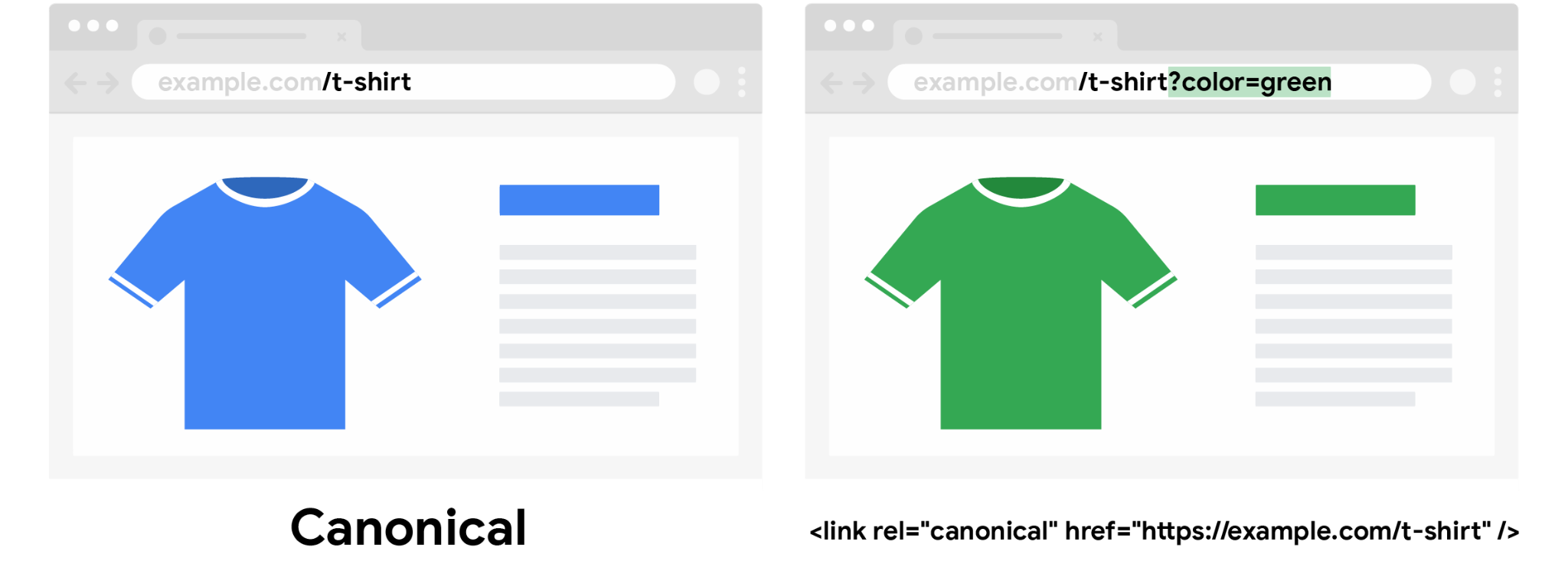Как создать структуру URL для сайта интернет-магазина
Если вы занимаетесь разработкой сайта самостоятельно, тщательно продумайте структуру URL. Тогда роботам Google будет проще находить и обрабатывать ваши страницы. В этом руководстве вы найдете советы, которые помогут вам избежать проблем при индексировании.
Почему нужно обращать внимание на структуру URL
Хорошо продуманная структура URL помогает роботам Google сканировать и индексировать ваш сайт. Если же структура продумана плохо, могут возникнуть следующие проблемы:
-
Робот Googlebot может пропустить часть материалов, если ошибочно посчитает, что два URL возвратят одинаковый контент (в такой ситуации поисковый робот сканирует только один URL, а вторую страницу расценивает как копию и игнорирует). Такое происходит в случаях, когда два URL различаются только идентификаторами фрагментов (например,
#fragment). Google не обрабатывает идентификаторы фрагментов при индексировании страниц.Пример. Страницы, в URL которых есть элементы
/product/t-shirt#blackи/product/t-shirt#white, будут считаться одинаковыми. -
Робот Googlebot может просканировать одну и ту же страницу несколько раз, если посчитает, что два URL различаются, хотя сервер в обоих случаях возвращает один и тот же контент. Это может замедлить сканирование сайта, а также неоправданно увеличить нагрузку на ваш веб-сервер.
Пример. URL с элементами
/product/black-t-shirtи/product?sku=1234могут относиться к одной странице, но по их структуре робот Googlebot не сможет это определить. -
Робот Googlebot может посчитать, что ваш сайт содержит бесконечное количество страниц, если в URL ресурса есть постоянно меняющееся значение, например временная метка. В результате для того, чтобы обнаружить весь полезный контент на вашем сайте, может потребоваться больше времени.
Пример. Робот Googlebot может прийти к выводу, что адреса
/about?now=12:34amи/about?now=12:35amотносятся к разным страницам, тогда как на самом деле по обоим показывается одна и та же.
Узнайте больше о том, как работает Google Поиск и как Google сканирует и индексирует ваш сайт.
Советы по созданию эффективной структуры URL
Чтобы роботам Google было проще сканировать и индексировать ваш сайт, следуйте приведенным ниже рекомендациям.
Как создавать URL
- Не создавайте разные URL, по которым находится один и тот же контент, чтобы роботам Google не приходилось выполнять лишние запросы. Чтобы проверить, не ведут ли два URL на одну и ту же страницу, зачастую требуется обработать оба.
- Если веб-сервер обрабатывает URL со строчными и прописными буквами одинаково, приведите все URL к одинаковому регистру. Так роботам Google будет проще разобраться в том, действительно ли определенные URL ведут на одну страницу.
- Убедитесь, что каждая страница в результатах поиска с разбивкой на страницы имеет собственный URL. По нашему опыту, большинство ошибок, связанных с URL, наблюдаются именно при использовании структуры с разбивкой на страницы.
-
Добавьте в пути URL описательные слова. Это поможет роботам Google анализировать страницы.
Рекомендуется:
/product/black-t-shirt-with-a-white-collarНе рекомендуется:
/product/3243
Как организовывать параметры запроса в URL
Если в URL используются параметры запроса, обратите внимание на следующее:
-
Старайтесь использовать в URL параметры вида
?key=value, а не?value. Благодаря этому роботам Google будет проще определять структуру сайта, а значит, они смогут более эффективно сканировать и индексировать его.Рекомендуется:
/photo-frames?page=2,/t-shirt?color=greenНе рекомендуется:
/photo-frames?2,/t-shirt?green -
Не используйте один и тот же параметр больше одного раза. Обнаружив несколько одинаковых параметров, робот Googlebot может игнорировать все из них, кроме одного.
Рекомендуется:
?type=candy,sweetНе рекомендуется:
?type=candy&type=sweet -
Не создавайте на сайте внутренние ссылки на временные параметры, такие как идентификаторы сеансов, коды отслеживания, значения, относящиеся к пользователям (
location=nearby,time=last-week), или текущее время. Из-за этого могут создаваться краткосрочные URL или копии URL, которые относятся к одной и той же странице. Чтобы обеспечить своему контенту наилучшие позиции в Google Поиске, пользуйтесь долгосрочными URL.Рекомендуется:
/t-shirt?location=UKНе рекомендуется:
/t-shirt?location=nearby,/t-shirt?current-time=12:02,/t-shirt?session=123123123
Как роботы Google распознают URL вариантов товаров
У владельцев сайтов интернет-магазинов часто возникают вопросы о том, как подготовить структуру URL на сайте, если какой-либо товар представлен в нескольких размерах или оттенках. Каждая разновидность товара с определенным сочетанием атрибутов называется вариантом товара. Чтобы роботам Google было проще различать варианты ваших товаров, убедитесь, что каждый вариант размещен по отдельному URL. Для URL вариантов товаров рекомендуется использовать следующую структуру:
-
сегмент пути, например
/t-shirt/green; -
параметр запроса, такой как
/t-shirt?color=green.
Дополнительную информацию можно найти в документации о структурированных данных для вариантов товаров.
Если вы различаете разновидности с помощью необязательных параметров запроса, то в качестве канонического URL лучше выбрать вариант, в котором параметр запроса пропущен. Благодаря этому роботам Google будет проще определять, как связаны между собой те или иные разновидности товаров.

Как использовать URL при работе с контентом
Чтобы в Google Поиске и Google Покупках правильно распознавались ваши товары и связи между их вариантами, при работе с URL на своем сайте учитывайте приведенные ниже рекомендации.
-
Используйте одинаковые URL во внутренних ссылках, файлах Sitemap и тегах
<link rel="canonical">. Предположим, на вашем сайте используется разбивка на страницы и по умолчанию в параметре URL указывается первая страница. В этом случае добавляйте элемент?page=1во все URL сайта или не добавляйте его никуда. -
Добавьте тег
<link rel="canonical">, содержащий URL самой страницы, на все страницы, которые предназначены для индексирования, и внесите эти URL в файл Sitemap. -
Если у каждого варианта товара есть страница с отдельным URL, разместите канонический URL товара на все такие страницы, используя тег
<link rel="canonical">. Дополнительная информация доступна в статье Справочного центра Google Merchant Center, посвященной атрибутуcanonical_link. -
Добавляйте ссылки непосредственно на страницы при помощи тегов
<a href>и не используйте код JavaScript для навигации по страницам. Навигация, настроенная с помощью такого кода, может быть не распознана роботом Googlebot. Подробнее о том, как Google обрабатывает код JavaScript… -
По возможности добавляйте информативный текст (например, название товара, на страницу которого ведет ссылка) между тегами
<a href>и</a>. От общих фраз, таких как "Нажмите здесь", лучше отказаться. -
Старайтесь не размещать ссылки на страницы, где нет полезного контента, и избегайте индексирования таких страниц. Для категории, в которой нет элементов, воспользуйтесь метатегом robots с директивой
noindex. Если та или иная категория на вашем сайте стала пустой и была автоматически удалена из поиска по сайту, то для страницы, связанной с этой категорией, лучше возвращать код статуса HTTP404 (not found).
Дополнительные ресурсы
Если вам нужна дополнительная информация, воспользуйтесь следующими ресурсами:
